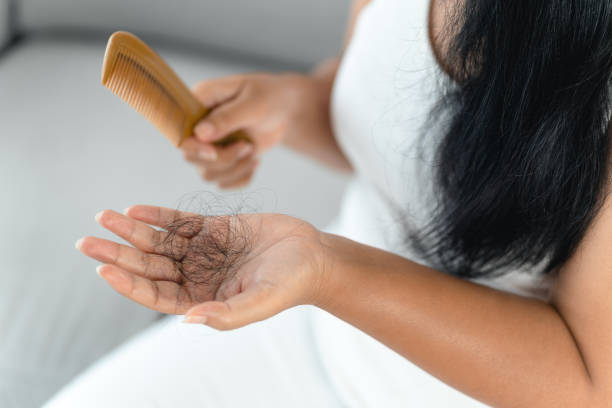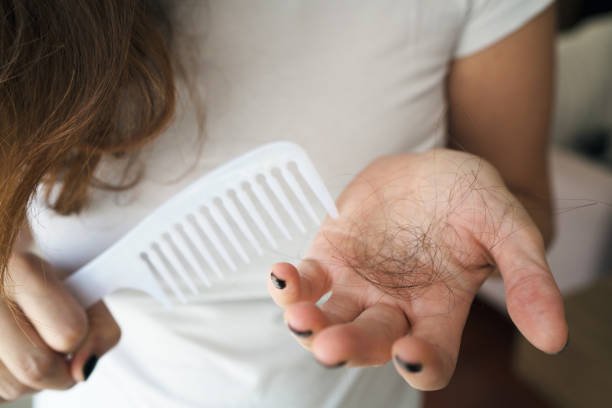Are you tired of finding strands of hair on your pillow or in the shower drain? Hair loss can be a distressing experience, affecting both men and women of all ages. Whether it’s due to genetics, hormonal changes, or lifestyle factors, losing your hair can have a significant impact on your self-esteem and confidence. But don’t worry!
In this blog post, we will explore the causes, symptoms, and treatment options for hair loss. From lifestyle changes to professional interventions, we’ve got you covered! So sit back, relax (but not too much), and let’s dive into the world of hair loss together. Get ready to say goodbye to those pesky shedding hairs and hello to healthy locks once again!
Causes of Hair Loss
Hair loss is a common condition that can affect both men and women. While it is normal to lose some hair on a daily basis, excessive hair loss can be concerning. Understanding the causes of hair loss can help you identify potential triggers and take steps to prevent or manage it.
Genetics
One of the primary causes of hair loss is genetics. If your family has a history of baldness or thinning hair, you may be more prone to experiencing it yourself. Hormonal changes can also play a significant role in hair loss, such as during pregnancy or menopause.
Important Read: The Ultimate Guide to Choosing the Best Hair Treatment for Your Specific Needs
Thyroid Disorder
Certain medical conditions like thyroid disorders, autoimmune diseases, and scalp infections can contribute to hair loss as well. Additionally, nutritional deficiencies, particularly iron deficiency anemia and protein deficiency, can weaken the hair follicles and lead to shedding.
Excessive Hairstyling
External factors such as excessive hairstyling practices (like frequent heat styling or tight hairstyles) and harsh chemical treatments (like perming or coloring) can damage the hair shafts over time. Stress is another factor that may contribute to temporary or prolonged periods of increased shedding.
Identifying the underlying cause(s) of your specific case of hair loss is crucial in determining the most appropriate treatment options for you. It’s important to consult with a healthcare professional who specializes in treating this condition so they can provide personalized recommendations tailored to your needs.

Common Symptoms of Hair Loss
Hair loss can manifest in various ways, and being aware of the common symptoms can help you identify the problem early on. Here are some signs to look out for:
- Excessive shedding: If you notice an increased amount of hair strands on your pillow, brush, or shower drain, it could be a sign of hair loss.
- Thinning hair: Gradual thinning is one of the most common symptoms. You may notice that your ponytail feels smaller or that your scalp is more visible than before.
- Receding hairline: Men often experience a receding hairline as their first symptom of hair loss. It usually starts with a slight recession at the temples and gradually progresses backward.
- Bald patches: Women may develop small bald patches on their scalp, which can be quite distressing and impact self-confidence.
- Itchy or painful scalp: Some people experiencing hair loss may also feel itching or discomfort on their scalp due to inflammation.
- Changes in texture and quality: Hair affected by thinning often becomes dry, brittle, and lacks volume.
Recognizing these symptoms early on can help you take necessary steps towards addressing your concerns effectively. Remember to consult with a professional like Image Clinic for an accurate diagnosis and personalized treatment plan tailored to address your specific needs.
Different Types of Hair Loss
Hair loss can occur for various reasons, and it is essential to understand the different types to determine the appropriate treatment. Here are some common types of hair loss:
- Androgenetic Alopecia: Also known as male or female pattern baldness, this type of hair loss is caused by a combination of genetics and hormones. It typically starts with thinning at the crown or receding hairline.
- Telogen Effluvium: This temporary condition occurs when there is an excessive shedding of hair due to stress, illness, hormonal changes, or certain medications. The hair follicles enter a resting phase prematurely, leading to noticeable thinning.
- Alopecia Areata: This autoimmune condition causes patchy hair loss on the scalp or other areas of the body. It occurs when the immune system mistakenly attacks healthy hair follicles.
- Traction Alopecia: This type of hair loss results from repetitive pulling or tension on the hair shafts due to tight hairstyles like braids, ponytails, or extensions.
- Trichotillomania: A psychological disorder characterized by compulsive pulling out of one’s own hair resulting in noticeable patches and significant distress.
Understanding these different types can help individuals seek appropriate treatment options and management techniques based on their specific condition.
Treatment Options for Hair Loss
When it comes to treating hair loss, there are several options available depending on the underlying cause and severity of the condition. It’s important to remember that what works for one person may not work for another, so it’s always best to consult with a healthcare professional or dermatologist before starting any treatment.
Medication
One common option is medication. Medications such as minoxidil and finasteride have been approved by the FDA for treating hair loss in both men and women. Minoxidil is applied topically and helps stimulate hair growth, while finasteride is taken orally and works by blocking the hormone responsible for hair loss.
Laser Therapy
Another popular treatment option is laser therapy. Low-level laser therapy (LLLT) involves using red light wavelengths to stimulate blood flow to the scalp and promote hair growth. This non-invasive procedure can be done at home with devices like laser combs or helmets, or in a clinical setting.
Hair Transplant
Hair transplant surgery is another option for those looking to restore their lost hair permanently. This procedure involves taking healthy hairs from one part of your body (usually the back of your head) and transplanting them onto balding areas. It’s a surgical procedure that should be performed by a qualified professional.
Acupuncture
In addition to these treatments, there are also alternative therapies that some people find helpful, such as acupuncture, herbal supplements, and essential oils. While these methods may not have scientific evidence backing their effectiveness in treating hair loss, they may still be worth exploring if you’re open to alternative approaches.
Finding the right treatment option takes time and patience. What works well for someone else might not work as effectively for you. It’s essential to consult with specialists who can evaluate your specific situation before making any decisions about how best to treat your hair loss.
Important Read: Hair Treatment: Procedure, Cost, and Side Effects in India
Lifestyle Changes to Prevent or Manage Hair Loss
Maintaining a healthy lifestyle can play a significant role in preventing or managing hair loss. Here are some simple yet effective lifestyle changes you can incorporate into your routine:
- Balanced Diet: Ensure that your diet includes essential nutrients like vitamins, minerals, and proteins. Include foods rich in iron, zinc, vitamin D, and omega-3 fatty acids to promote healthy hair growth.
- Avoid Harsh Styling: Limit the use of heat styling tools like straighteners and curling irons as they can damage your hair follicles. Opt for natural hairstyles instead of tight ponytails or braids that pull on your hair.
- Gentle Hair Care Routine: Use mild shampoos and conditioners suitable for your hair type. Avoid excessive brushing when wet as it can lead to breakage.
- Stress Management: Chronic stress is known to contribute to hair loss. Incorporate stress-reducing activities like exercise, meditation, or hobbies into your daily routine.
- Quit Smoking: Smoking damages the blood vessels leading to poor circulation which affects the health of your scalp and hair follicles.
- Regular Exercise: Engaging in regular physical activity improves overall blood circulation including that of the scalp promoting healthier hair growth.
Remember, these lifestyle changes may take time to show results; consistency is key! By making these small adjustments, you can support healthier-looking locks and reduce the risk of further hair loss.

When to Seek Professional Help
If you’ve been experiencing significant hair loss and it’s starting to affect your self-esteem or overall well-being, it may be time to seek professional help. While some amount of hair shedding is normal, excessive hair loss could be a sign of an underlying medical condition or nutritional deficiency.
A dermatologist specializing in hair disorders can assess your situation and recommend appropriate treatment options. They will conduct a thorough examination of your scalp and hair follicles to determine the cause of your hair loss. This may involve taking a detailed medical history, performing blood tests, or even conducting a scalp biopsy.
It’s important not to ignore persistent or worsening symptoms. Seeking professional help early on can improve the chances of successful treatment and prevent further damage to your hair follicles. Remember that every individual is unique, and what works for one person may not work for another.
In addition to dermatologists, there are trichologists who specialize specifically in treating hair and scalp conditions. These professionals have extensive knowledge about the causes of various types of hair loss and can provide personalized advice tailored to your specific needs.
Don’t hesitate to reach out for professional assistance if you’re concerned about your thinning hair or excessive shedding. Early intervention can make a significant difference in managing and potentially reversing the effects of hair loss.
Conclusion – Best Hair Loss Treatment for Men in 2023
Hair loss can be a distressing experience for both men and women, but understanding its causes, symptoms, and treatment options can help you take control of the situation. Whether it’s due to genetic factors, hormonal changes, or lifestyle habits, there are steps you can take to prevent or manage hair loss.
If you are experiencing significant hair loss or if your hair loss is accompanied by other concerning symptoms, it may be time to seek professional help. A qualified dermatologist or trichologist will be able to assess your condition and recommend appropriate treatment options.
Remember that everyone’s journey with hair loss is unique, and what works for one person may not work for another. It’s important to have patience and perseverance as you explore different treatments and make necessary lifestyle changes.
At Image Clinic in Kolkata, we offer advanced hair restoration solutions tailored to individual needs. Our team of experienced professionals specializes in providing the best possible care for damaged hair through various techniques such as PRP therapy, mesotherapy, laser therapy, and more.
Do not let hair loss define your self-esteem or confidence. Take action today towards healthier-looking locks by seeking professional guidance at Image Clinic – where expertise meets compassion!Locate Us


